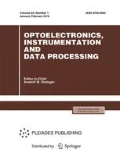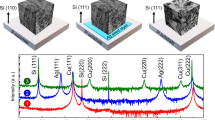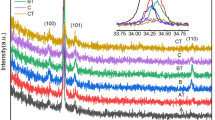Abstract
The results of investigating the generation of strained nanoheterostructures based on compounds with materials of group IV (Ge, Si, Sn) are presented. It is established how silver, tin, and lead atoms diffuse over the surface and what temperature dependences of diffusion coefficients are specific to atoms of these elements. It is shown that the diffusion of silver, tin, and lead atoms follows the mechanism of solid-phase wetting with generation of surface phases. The experimental data are provided that indicate the dominating role of edge dislocations and dislocation complexes of edge type in relaxation of Ge/Ge\({}_{0.5}\)Si\({}_{0.5}\)/Si(001) heterostructure. Tin-rich islands with Si pedestal on Si(001) substrate were obtained by the molecular beam epitaxy method. Firstly, the Sn film was applied on the Si surface. During the subsequent annealing an array of Sn islands, which were further used as catalysts for growing nanoobjects, was formed. Tin-rich islands with Si pedestal are formed after deposition of silicon at temperatures of 300–450\({}^{\circ}\)C on the surface with Sn islands. The growth of islands with pedestal occurred by the vapor–liquid–crystal mechanism. Intense photoluminescence was revealed from the tin-rich islands with Si pedestals in the wavelength range 1.3–1.7 \(\mu\)m.





Similar content being viewed by others
REFERENCES
M. R. Bauer, J. Tolle, C. Bungay, A. V. G. Chizmeshya, D. J. Smith, J. Menéndez, and J. Kouvetakis, ‘‘Tunable band structure in diamond–cubic tin–germanium alloys grown on silicon substrates,’’ Solid State Commun. 127, 355–359 (2003). https://doi.org/10.1016/S0038-1098(03)00446-0
S. Wirths, R. Geiger, N. von den Driesch, G. Mussler, T. Stoica, S. Mantl, Z. Ikonic, M. Luysberg, S. Chiussi, J. M. Hartmann, H. Sigg, J. Faist, D. Buca, and D. Grutzmacher, ‘‘Lasing in direct-bandgap GeSn alloy grown on Si,’’ Nature Photon. 9, 88–92 (2015). https://doi.org/10.1038/nphoton.2014.321
A. Mosleh, M. A. Alher, L. C. Cousar, W. Du, S. A. Ghetmiri, Th. Pham, J. M. Grant, G. Sun, R. A. Soref, B. Li, H. A. Naseem, and Sh.-Q. Yu, ‘‘Direct growth of Ge\({}_{1-x}\)Sn\({}_{x}\) films on Si using a cold-wall ultra-high vacuum chemical-vapor-deposition system,’’ Front. Mater. 2, 30 (2015). https://doi.org/10.3389/fmats.2015.00030
R. Chen, S. Gupta, Y.-Ch. Huang, Y. Huo, Ch. W. Rudy, E. Sanchez, Y. Kim, Th. I. Kamins, K. C. Saraswat, and J. S. Harris, ‘‘Demonstration of a Ge/GeSn/Ge quantum-well microdisk resonator on silicon: enabling high-quality Ge (Sn) materials for micro-and nanophotonics,’’ Nano Lett. 14, 37–43 (2014). https://doi.org/10.1021/nl402815v
S. Gupta, B. Magyari-Köpe, Yo. Nishi, and K. C. Saraswat, ‘‘Achieving direct band gap in germanium through integration of Sn alloying and external strain,’’ J. Appl. Phys. 113, 073707 (2013). https://doi.org/10.1063/1.4792649
H. Y. Hui, M. de la Mata, J. Arbiol, and M. A. Filler, ‘‘Low-temperature growth of axial Si/Ge nanowire heterostructures enabled by trisilane,’’ Chem. Mater. 29, 3397–3402 (2017). https://doi.org/10.1021/acs.chemmater.6b03952
S. Assali, A. Dijkstra, A. Li, S. Koelling, M. A. Verheijen, L. Gagliano, N. von den Driesch, D. Buca, P. M. Koenraad, J. E. M. Haverkort, and E. P. A. M. Bakkers, ‘‘Growth and optical properties of direct band gap Ge/Ge\({}_{0{,}87}\)Sn\({}_{0{,}13}\) Core/Shell nanowire arrays,’’ Nano Lett. 17, 1538–1544 (2017). https://doi.org/10.1021/acs.nanolett.6b04627
M. Jeon, H. Uchiyama, and K. Kamisako, ‘‘Characterization of Tin-catalyzed silicon nanowires synthesized by the hydrogen radical-assisted deposition method,’’ Mater. Lett. 63, 246–248 (2009). https://doi.org/10.1016/j.matlet.2008.10.005
R. S. Wagner and W. C. Ellis, ‘‘Vapor-liquid-solid mechanism of single crystal growth,’’ Appl. Phys. Lett. 4, 89–90 (1964). https://doi.org/10.1063/1.1753975
E. I. Givargizov, ‘‘Fundamental aspects of VLS growth,’’ J. Crystal Growth. 31, 20–30 (1975). https://doi.org/10.1016/0022-0248(75)90105-0
A. E. Dolbak and B. Z. Ol’shanetskii, ‘‘Diffusion of silver over atomically clean silicon surfaces,’’ J. Exp. Theor. Phys. 143, 952–956 (2013). https://doi.org/10.1134/S1063776113060046
W. M. Lomer, ‘‘A dislocation reaction in the face-centred cubic lattice,’’ Philos. Mag. 42, 1327–1331 (1951). https://doi.org/10.1080/14786444108561389
S. Mader, A. E. Blakeslee, and J. Angilello, ‘‘The interpretation of dislocation contrast in x-ray topographs of GaAs\({}_{1-x}\)P\({}_{x}\),’’ J. Appl. Phys. 45, 4730–4734 (1974). https://doi.org/10.1063/1.1663126
E. P. Kvam, D. M. Maher, and C. J. Humpreys, ‘‘Variation of dislocation morphology with strain in Ge\({}_{x}\)Si\({}_{1-x}\) epilayers on (100) Si,’’ J. Mater. Res. 5, 1900–1907 (1990). https://doi.org/10.1557/JMR.1990.1900
A. E. Dolbak and R. A. Zhachuk, ‘‘Diffusion of Ag, Sn, and Pb over atomically clean Ge(111) surface,’’ J. Exp. Theor. Phys. 129, 391–396 (2019). https://doi.org/10.1134/S1063776119080028
T. Ichikawa, ‘‘Structural study of ultrathin Sn layers deposited onto Ge(111) and Si(111) surfaces by RHEED,’’ Surf. Sci. 140, 37–63 (1984). https://doi.org/10.1016/0039-6028(84)90380-7
Yu. B. Bolkhovityanov, A. S. Deryabin, A. K. Gutakovskii, L. V. Sokolov, and A. P. Vasilenko, ‘‘Dislocation interaction of layers in the Ge/Ge-seed/Ge\({}_{x}\)Si\({}_{1-x}\)/Si(001) (\(x=0.3{-}0.5\)) system: trapping of misfit dislocations on the Ge-seed/GeSi interface,’’ Acta Mater. 61, 617–621 (2013). https://doi.org/10.1016/j.actamat.2013.05.028
Yu. B. Bolkhovityanov, A. S. Deryabin, A. K. Gutakovskii, and L. V. Sokolov, ‘‘Unzipping and movement of Lomer-type edge dislocations in Ge/GeSi/Si(001) heterostructures,’’ J. Cryst. Growth 483, 265–268 (2018). https://doi.org/
Y. B. Bolkhovityanov, A. S. Deryabin, A. K. Gutakovskii, and L. V. Sokolov, ‘‘Unexpected travel of Lomer-type dislocations in Ge/Ge\({}_{x}\)Si\({}_{1-x}\)/Si(001) heterostructures,’’ Thin Solid Films 616, 348–350 (2016). https://doi.org/10.1016/j.tsf.2016.08.058
A. I. Nikiforov, V. A. Timofeev, V. I. Mashanov, T. A. Gavrilova, and D. V. Gulyaev, ‘‘Elastically stressed pseudomorphic SiSn island array formation with a pedestal on the Si(100) substrate using Sn as a growth catalyst,’’ J. Cryst. Growth 518, 103–107 (2019). https://doi.org/10.1016/j.jcrysgro.2019.04.021
R. R. Kumar, K. N. Rao, K. Rajanna, and A. R. Phani, ‘‘Growth of tin catalyzed silicon nanowires by electron beam evaporation,’’ Adv. Mat. Lett. 4, 836–840 (2013). https://doi.org/10.5185/amlett.2013.3449
V. Schmidt, S. Senz, and U. Gösele, ‘‘Diameter-dependent growth direction of epitaxial silicon nanowires,’’ Nano Lett. 5, 931–935 (2005). https://doi.org/10.1021/nl050462g
V. A. Timofeev, A. I. Nikiforov, A. R. Tuktamyshev, V. I. Mashanov, I. D. Loshkarev, A. A. Bloshkin, and A. K. Gutakovskii, ‘‘Pseudomorphic GeSiSn, SiSn and Ge layers in strained heterostructures,’’ Nanotechnology 29. P. 154002 (2018). https://doi.org/10.1088/1361-6528/aaac45
Author information
Authors and Affiliations
Corresponding author
Additional information
Translated by E. Oborin
About this article
Cite this article
Deryabin, A.S., Dolbak, A.E., Esin, M.Y. et al. Molecular Beam Epitaxy of Strained Nanoheterostructures Based on Si, Ge, and Sn. Optoelectron.Instrument.Proc. 56, 470–477 (2020). https://doi.org/10.3103/S8756699020050039
Received:
Revised:
Accepted:
Published:
Issue Date:
DOI: https://doi.org/10.3103/S8756699020050039




